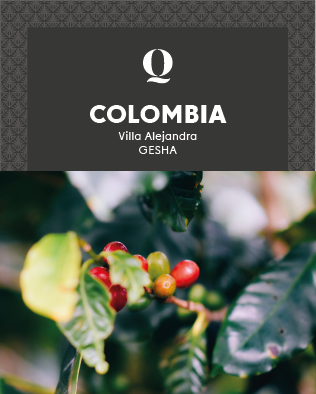Gesha aka Geisha coffee is one of the most exclusive coffees in the world. It is essentially a varietal and had become synonymous with Panama and although it has encouraged many producers in Central and South America to plant this varietal, it remains a unique, rare, and pricey coffee.
THE NAME DEBATE - origin
There has been huge debate in the whole Gesha or Geisha – what should it be called, and which is the correct name for it. Perhaps reading this, you can make your own mind up – as you can see, we have!
The Gesha variety of coffee originated in – yes you guessed it – Ethiopia, the birthplace of coffee and specifically in a village called Gesha, in the Gesha region of southwestern Ethiopia. And there it is! The biggest clue of all and why we went with this version of the name; it just makes sense right?
The other side of the name story goes, that it was kind of lost in translation and the pronunciation changed to Geisha along the way. It is quite sad, that plenty of coffee roasters and coffee companies, have, particularly in the past deliberately associated the coffee with branding depicting the idea of Japanese geishas or generally Japanese inspired.
The variety was actually identified as such in the 1930s in the region I mentioned above and in 1936 the seeds were collected by the British consul. What happened to these collected seeds? They were sent, initially to Uganda and Tanzania and were planted as experimental lots for research. From there, they made their way over to Central America, specifically Costa Rica. The journey the Gesha varietal took from there is quite interesting…

PANAMA
Panama? Yes. If you know your coffee, particularly if you know about Gesha, then undoubtedly you have heard of Panama Geisha and this is how the story goes. In the 1950s the varietal landed and was planted in Panama too. Between Costa Rica and Panama, Gesha was then quite insignificant in comparison, though still rare and was mainly used in blends (the horror huh?)
It was in 2004, that Gesha coffee gained the recognition it deserved and entered the specialty coffee scene. And it entered with a bang!
Hacienda La Esmeralda a farm in Panama, took the bold decision to enter the coffee in that year’s Best of Panama Coffee Competition. The competition is known for having high dollar coffee at the auctions. The Gesha coffee that Hacienda La Esmeralda brought to the competition was found to have a distinct unusual taste. The lot created a true sensation and it not only won the competition, but it was purchased at auction for a record price of $21/lb.
Fifteen years after this event, in the same competition, another Gesha from the Lamastus Family Estates, sold for $1,029/lb!! This particular coffee gained the nickname ‘Elida Natural Geisha 1029’. There were 100 lb of Gesha sold for over $100,000 (above the next closest ranking coffee by $80,000).
It is I think fair to say that Gesha is perhaps the most valuable coffee in the world – although in recent years, Yemeni coffee is also being sold for high dollar – and that is another interesting story.

GESHA COFFEE TODAY
Gesha coffee in terms of flavour profile is the main reason for it being renowned. The coffee is known for its sweet with a combination of chocolate, fruits, and floral notes too, all contributing to the high price tag and prestige.
Although Gesha has low productivity it is a hardy variety and is somewhat resistant to coffee leaf rust. This, along with the high prices it brings in the market, is what has made it incredibly attractive to many farmers in Central and South America.
In recent years, Colombia has entered the Gesha world and has done really well. It has produced amazing Gesha coffees, equally fetching high prices, equally rare. Some Kenyan Gesha coffees have also been popping up in recent years too.
OUR COFFEE – Colombia Villa Alejandra
Our coffee comes from one of these Colombian farms that are cultivating these superb little gems! The farm is owned by Victor Eliecer Garzon and Villa Alejandra is a 7 hectare farm The farm sits on the Corralejas, Sotara Region in Cauca Colombia. The soil in 6 out of the 7 hectares is clay loam and volcanic and this is where the Gesha coffee cherries are able to thrive.

Victor harvests his Gesha coffee cherries when they have reached a bright red colour, and this happens at around every 20 days during the whole of the harvest season. The coffee is then de-pulped, and this is done on the same day it is harvested. The seeds are then fermented for 24 hours dry. Following this, the coffee is then washed three times and dried in a combination of casa elbadryers and parabolic dryers – this process takes place for 10 days.
IT IS TRUE…
Nor everyone loves Gesha coffee and not everyone is willing to pay the price, but the truth of the matter is that it is hard to get better than a Gesha. Gesha coffees have been able to break every existing global record for price, sometimes reaching absurd amounts of money.
It has fueled, however, the imagination of the farmers around the globe and has built their expectations of being able to fetch these high prices. I talked about risks that farmers take before and cultivating Gesha is definitely a huge one. But just like I’ve previously said, on my other coffee musings, these risks are taken and sometimes they pay off (excuse the pun but it is true!)
So, without further ado, this coffee fortunately for you and us, is a fabulous example of a Gesha coffee that you (or a very special person to you 😉) can have the opportunity to taste!


